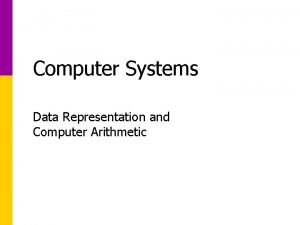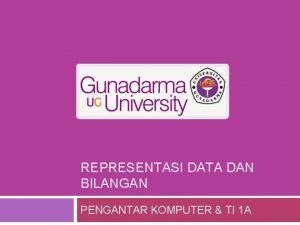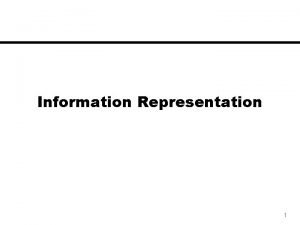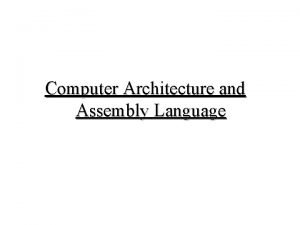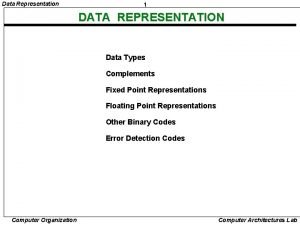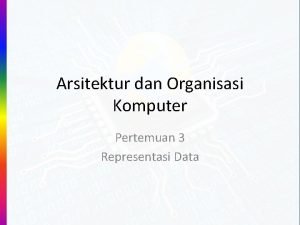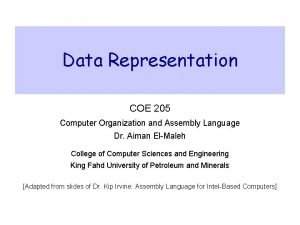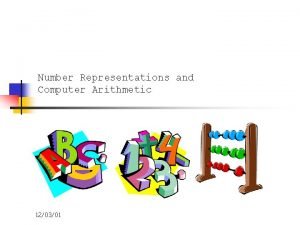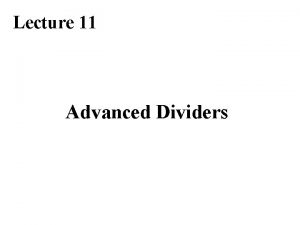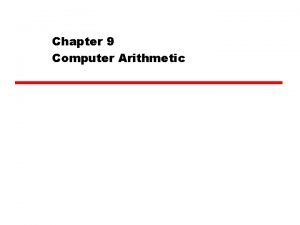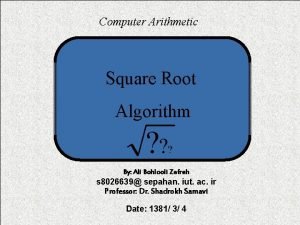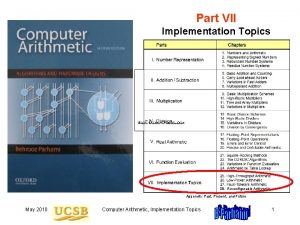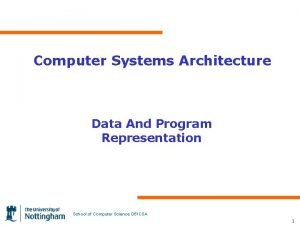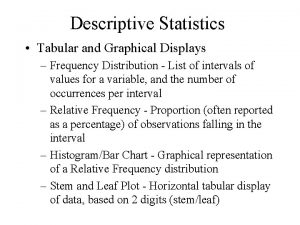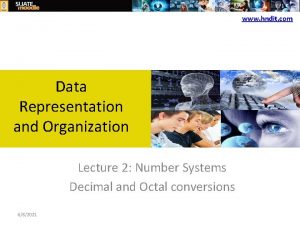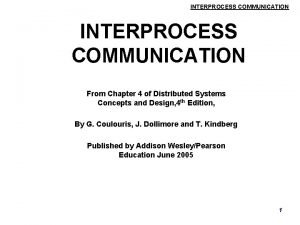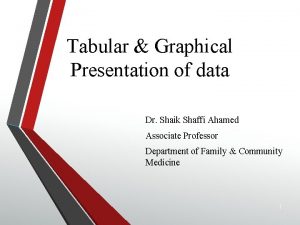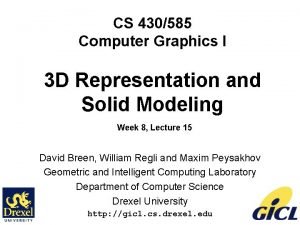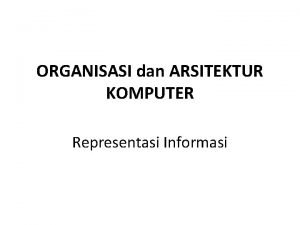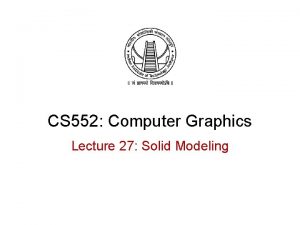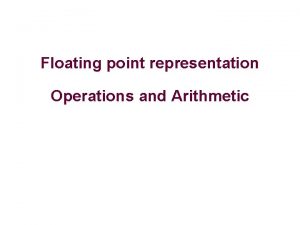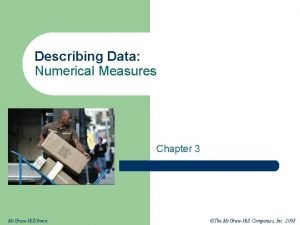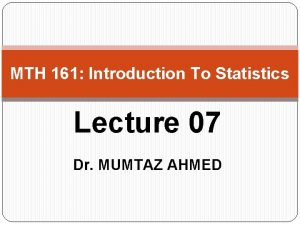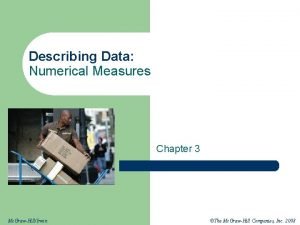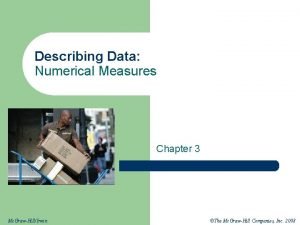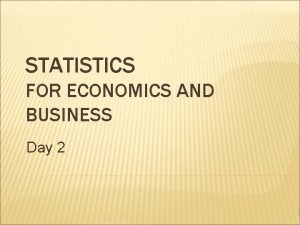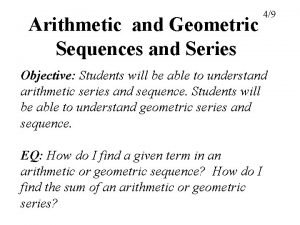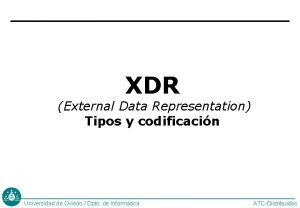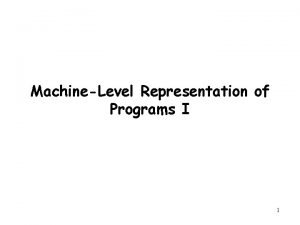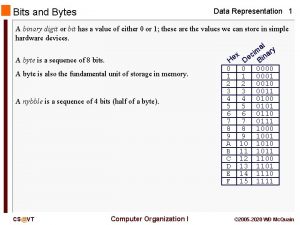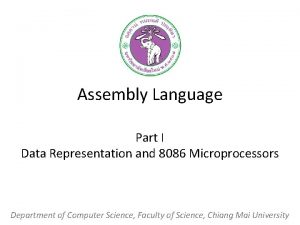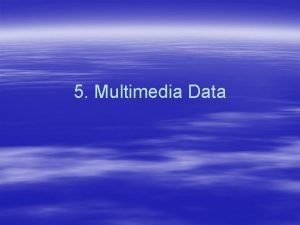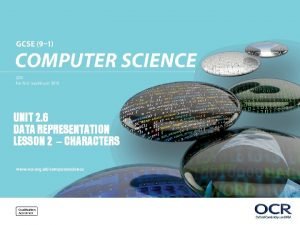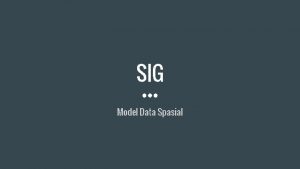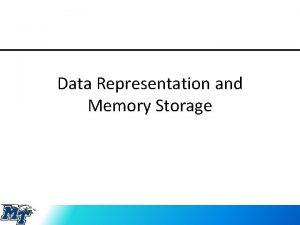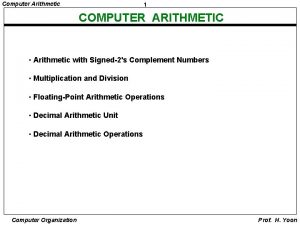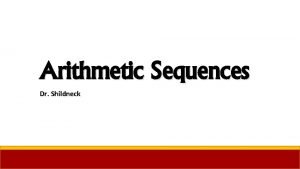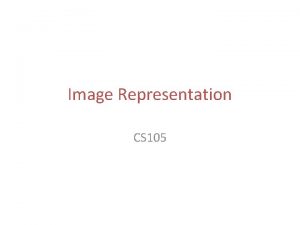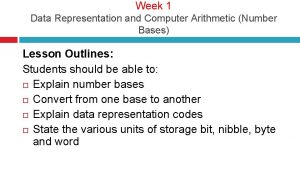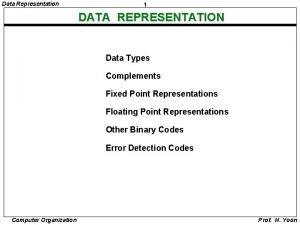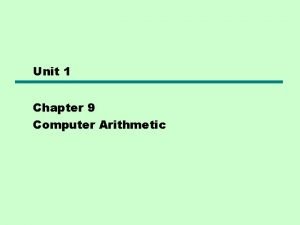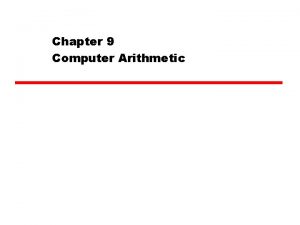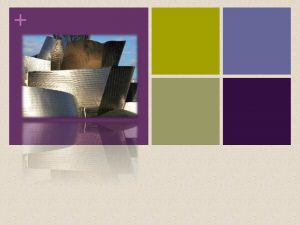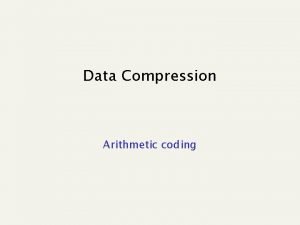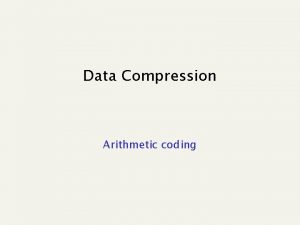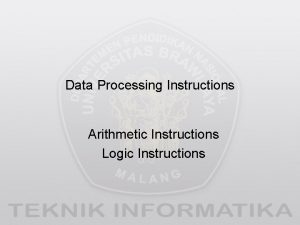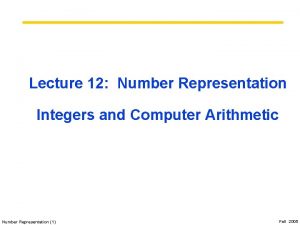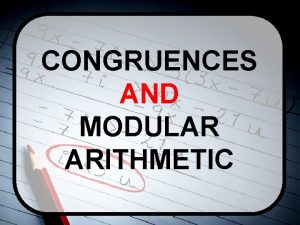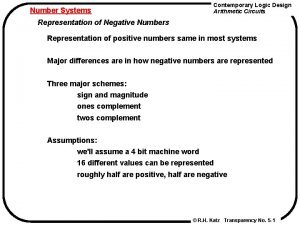Computer Systems Data Representation and Computer Arithmetic Data







































- Slides: 39

Computer Systems Data Representation and Computer Arithmetic

Data Representation • Binary codes used to represent numbers • Conversion between number systems – Binary decimal – Hexadecimal – Between arbitrary number systems • Representation of positive/negative numbers • Floating point representation

Bit, Byte and Word • Bit is the smallest quantity that can be handled by computer: 1 or 0. • Byte is a group of 8 bits. • Word is the basic unit of data that can be operated by computer: e. g. , 16 bits. 11001010 00001101 Byte Word Bit • Some architectures have 8, 32, or 64 -bit words

Content of Word • Bit Pattern • May represent many things • Actual meaning of a particular bit pattern is given by the programmer • Computer itself cannot determine the meaning of the word • Classic question: Can you tell the meaning of a word picked randomly from the memory?

• Instruction: (op-code) A single word defines an action that is to be performed by CPU • Numeric Quantity • Character: A to Z, a to z, 0 to 9, *, -, +, etc. • ASCII Code: - Representation of a character by 7 bits. - The ASCII for W is 101 01112, or 5716

ASCII Code

Pixel (Picture Element) • • The smallest unit to construct a picture 1 bit/pixel for black-and-white pictures, >1 bits/pixel for gray scale or color pictures, e. g. 24 bits/pixel. • A letter is represented by a group of pixels on computer screen. Pixel (1)

Positional Notation • Weight is associated with the location within a number. • The 9 in 95 has weight 10 • A number N in base b is represented by

Example:

Number Bases • Decimal (b=10): {0, 1, 2, 3, 4, 5, 6, 7, 8, 9} • Binary (b=2): {0, 1} • Octal (b=8): {0, 1, 2, 3, 4, 5, 6, 7} • Hexadecimal (b=16): {0, 1, 2, 3, 4, 5, 6, 7, 8, 9, A, B, C, D, E, F}

How many binary bits are needed to represent an n-digits decimal? The value of an m-bit binary is up to The value of an n-digit decimal is up to so OR

Questions How many bits are needed to represent an n-digits octal? How many bits are needed to represent an n-digits hexadecimal?

Conversion of Integer - Decimal to Binary • Divide a decimal successively by 2, record the remainder, until the result of the division is 0. 67/2 = 33 33/2 = 16 16/2 = 8 8/2 = 4 Rem. =1 Rem. =0 4/2 2/2 1/2 =2 =1 =0 Rem. =1

Conversion of Integer - Decimal to Hexadecimal • Divide a decimal successively by 16, record the remainder, until the result is 0 432/16 = 27 27/16 = 1 1/16 =0 Rem. =B Rem. =1

Conversion of integer - Binary to Decimal Conversion of integer - Hexadecimal to Decimal

Conversion of integer - Hexadecimal 01010111 5 2 Binary B 7 0010 1011 0111 7 Conversion of integer: - Octal Binary 01010111 1 2 7 2 5 7 010 101 111

Conversion of Fraction - Decimal to Binary • The fraction is repeatedly multiplied by 2, the integer part is stripped and recorded. 0. 687510 = 0. 10112 0. 687510 * 2 =1. 375 0. 37510 * 2 = 0. 7510 * 2 = 1. 5 0. 510 * 2 = 1. 0 0. 010 * 2 = 0. 0 1 1 end Question: Convert 0. 625? 0. 110?

Conversion of Fraction - Binary Hexadecimal 0. 1010110012 = 0. 1010 1100 10002 = 0. AC 816 0. 7 BC 16 = 0. 0111 1011 11002 = 0. 011112 Convert 0. 6 D 5? Convert 0. 1100101011

Binary Coded Decimal (BCD) • A decimal digit is coded into 4 bits 1 byte can store 2 digits Decimal 0 • Example: 1 2 1942 is encoded as 3 0001 1001 0100 0010 (2 bytes) 4 5 • Disadvantages • Complex arithmetic • Inefficient use of storage • Advantage: • Can represent “real” number 6 7 8 9 BCD 0000 0001 0010 0011 0100 0101 0110 0111 1000 1001

Binary Addition + 0 0 1 1 0 1 1 1 0 0 1 1 0 1 Carry Binary Subtraction ? • use 2’s complementary arithmetic (later … )

Signed Integer Representations • Sign-and-Magnitude • 1’s Complement • 2’s Complement

Sign-and-Magnitude Representation • Use the most significant bit (MSB) to indicate the sign of the number. • The MSB is 0 for positive, 1 for negative. • 8 bits represent -12710 to 12710 • Examples: 00101100 for +44 10101100 for -44 10 10 Problem: 0000 = +0, 10000000 = -0

1’s Complement • Just flip the bits! • The MSB is 0 for positive, 1 for negative. • 8 bits represent -12710 to 12710 • Examples: 00101100 for +44 11010011 for -44 10 10 Problem: 0000 = +0, 1111 = -0

2’s Complement • The 2’s complement for N is • Example: Using 5 bits (n = 5), if N = 7, then 01100 12 + 11001 -7 1) 0 0 1 5 • 2’s complement = 1’s complement + 1 7 00111 1’s complement 11000 + 1 2’s complement 1 1 0 0 1 = -7

2’s Complement (con. ) • To form the two’s complement of a number, simply invert the bits (1 to 0, 0 to 1), and add 1 1’s complement + 1 1310 = 0 0 1 1 0 1 -1310 = 1 1 0 0 1 0 + 1 =1111 0011 2’s comp. -34?

Properties of 2’s Complement • One unique 0 • MSB = 0, positive number • MSB = 1, negative number • The range is • For 5 bits, the range is -1610 (10000) to +1510 (01111) • The 2’s complement of the complement of X is X itself (Prove: )

2’s Complementary Arithmetic • Subtraction is performed using addition A - B = A + (-B) X = 910 = 010012, -X = -910 = 101112, Y = 610 = 001102 -Y = -610 = 110102 X -Y 3 - X - Y -15 10 01001 + 11010 1) 0 0 0 1 1 10 10111 + 11010 1) 1 0 0 0 1

Binary Adder/Subtractor

Arithmetic Overflow • The overflow happens when positive + positive negative + negative positive • If are MSBs, then the overflow bit v is expressed as 12 +13 25 01100 + 01101 11001 -12 -13 -25 10100 + 10011 1) 0 0 1 1 1

Arithmetic Overflow • In practice, • Case I: A and B are + an-1 = __ bn-1 = __ cn-1 = __ V = _____ • Case II: A and B are – an-1 = __ bn-1 = __ cn-1 = __ V = _____ Most significant stage of full adder

Fixed-point Arithmetic 3. 62510 0011. 10102 + 6. 510 0110. 10002 + 10. 12510 00111010 0110100010 The fraction point is added 10100010 -> 1010. 00102 What if we want to represent ? We need at least m > 3. 3*n = 3. 3*20 = 66 bits !

Floating Point Numbers • Scientific Notation a is mantissa, r is radix, e is exponent • is for binary

IEEE Floating Point Format S: Sign bit, 1 bit E: Exponent, 8 bits B: Bias, 8 bits, 12710=0111 1111 F: mantissa

IEEE Floating Point - Example • Normalization, e. g. , • Use sign and magnitude representation for signed mantissa. • Use biased exponent, e. g. in excess 127 • If we have 8 bits for exponent, to represent -5, we add 12710 (0111 1111) to -5, the result is 12210=0111 10102.

IEEE Floating Point - Example Represent -2345. 125 in 32 bits ? -2345. 125 = -1001001. 0012 1) Normalization: 2) Negative mantissa, so S = 1 3) Exponent: E = 11 + 127 = 13810 = 100010102 4) Mantissa F = 001001 0010… 000 1 10001010 001001001000… 0 1. 510 in IEEE format?

IEEE Floating Point Format – Special Cases • Zero: exponent and fraction all 0 s • Denormalized: exponent all 0 s, fraction non-zero for single precision: • Infinity: exponents all 1 s, fraction all 0 s sign bit determines +infinity or -infinity • Not a Number (Na. N): exponents all 1 s, fraction non-zero • A good reference is available at http: //research. microsoft. com/~hollasch/cgindex/coding/ieeefloat. html

Bit Patterns and Logical Operations • AND • OR • NOT • Exclusive OR They are bit-wise operations.

AND Operation • x AND y is true, if and only if both bits x and y are true. A=11001011 B=01101101 C=A AND B =01001001 OR Operation • x OR y is true, if either bits x or y is true. C=A OR B A=11001011 B=01101101 =11101111

NOT Operation • A 1 becomes 0, and a 0 becomes 1. A=11001011 C = NOT A = 0 0 1 1 0 0 EOR (Exclusive OR) Operation • It is true, if and only if just one of inputs is true. A=11001011 B=01101101 C = A EOR B = 1 0 0 1 1 0
 Data representation and computer arithmetic
Data representation and computer arithmetic Data representation computer science
Data representation computer science Computer memory representation
Computer memory representation Data representation in computer architecture
Data representation in computer architecture Data types in data representation
Data types in data representation Karakter alfanumerik
Karakter alfanumerik Data representation in computer organization
Data representation in computer organization Fftooo
Fftooo Computer arithmetic
Computer arithmetic Behrooz parhami computer arithmetic
Behrooz parhami computer arithmetic Fixed point addition and subtraction flowchart
Fixed point addition and subtraction flowchart Square root algorithm
Square root algorithm William stallings computer organization and architecture
William stallings computer organization and architecture Computer arithmetic
Computer arithmetic Ascii definition computer science
Ascii definition computer science Tabular and graphical representation of data
Tabular and graphical representation of data Data representation and organization
Data representation and organization Request reply protocol in distributed system
Request reply protocol in distributed system Tabular and graphical representation of data
Tabular and graphical representation of data Boundary representation in computer graphics
Boundary representation in computer graphics Information representation in computer
Information representation in computer Sweep representation in computer graphics
Sweep representation in computer graphics Floating point number representation
Floating point number representation Surface representation in computer graphics
Surface representation in computer graphics Decision support systems and intelligent systems
Decision support systems and intelligent systems Interquartile range calculator for grouped data
Interquartile range calculator for grouped data Arithmetic mean of grouped data example
Arithmetic mean of grouped data example Arithmetic mean grouped data formula
Arithmetic mean grouped data formula Arithmetic mean examples for grouped data
Arithmetic mean examples for grouped data Arithmetic mean for grouped data example
Arithmetic mean for grouped data example Arithmetic mean formula for grouped data
Arithmetic mean formula for grouped data Arithmetic and geometric sequences and series
Arithmetic and geometric sequences and series Xdr external data representation
Xdr external data representation Machine level representation of programs
Machine level representation of programs Data representation in memory bit
Data representation in memory bit Data types in assembly language 8086
Data types in assembly language 8086 Audio data representation
Audio data representation Unit 2 data representation
Unit 2 data representation Graphical representation
Graphical representation Data representation in memory
Data representation in memory
